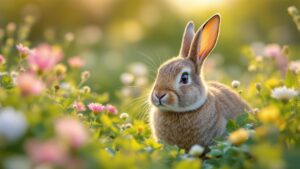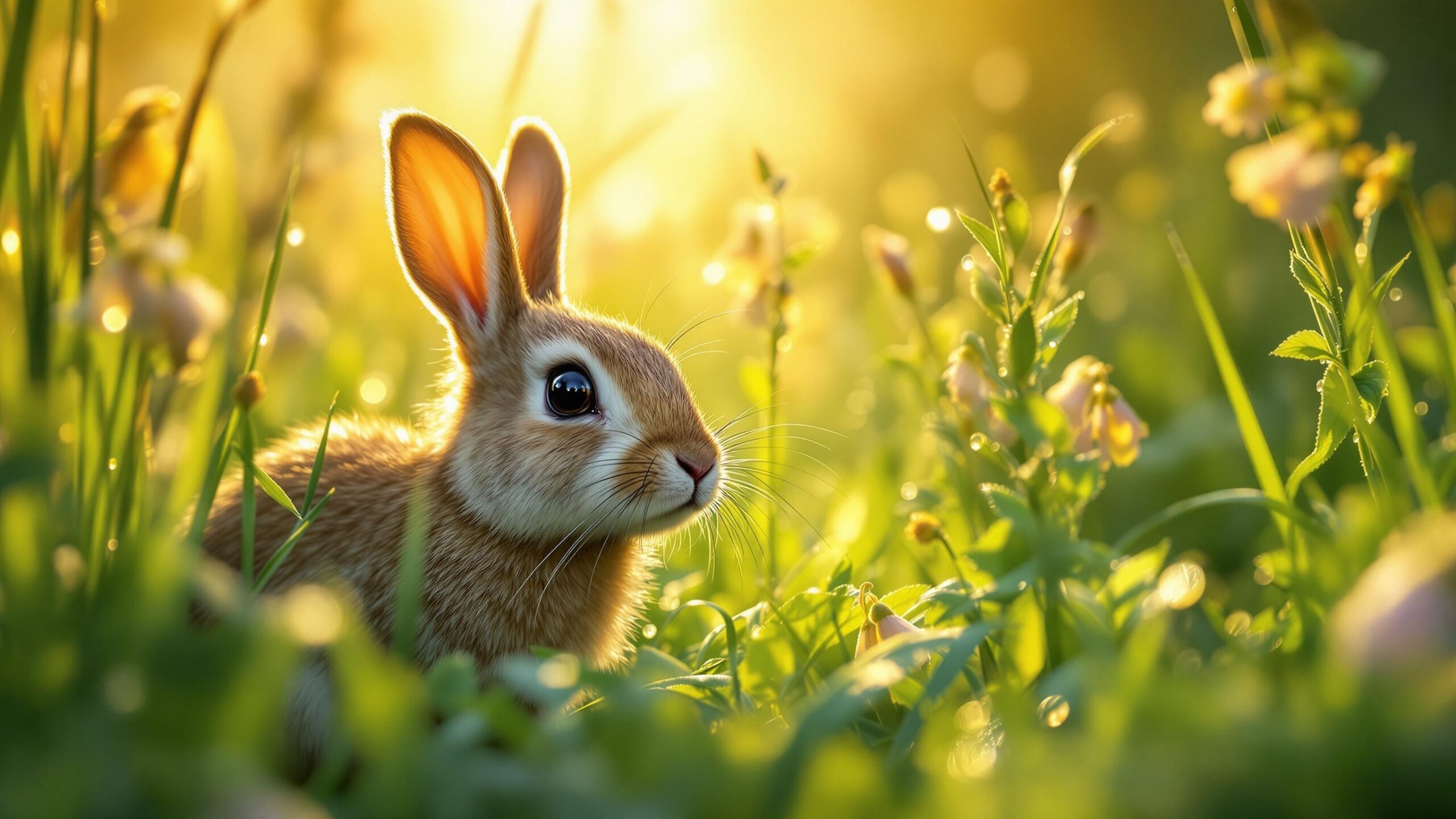Rabbits: Nature’s Nimble Nomads of Field and Forest
From their twitching noses and long ears to the powerful hind legs that carry them in bursts across open meadows, rabbits are among the most beloved and widespread mammals on Earth. They are instantly recognizable yet surprisingly complex, creatures that have played roles in mythology, science, agriculture, and the wild ecosystems of every continent except Antarctica. Whether nibbling clover in a backyard garden or darting into a hedgerow to escape a fox, rabbits embody adaptability and alertness. This article dives into the captivating world of rabbits, offering a deep and diverse look at the biological wonders and ecological importance of this remarkable animal family.
Rabbits belong to the order Lagomorpha, which includes hares and pikas, and the family Leporidae, which is where all true rabbits and hares reside. These herbivorous mammals are characterized by their continuously growing incisors, double-layered upper teeth, and efficient digestive systems designed for extracting nutrients from fibrous vegetation. They are typically small to medium in size, with soft fur, sensitive whiskers, and large eyes adapted to dawn and dusk activity. Their powerful hind legs are built for speed and leaping, and their quiet, communal lifestyles are intricately linked to survival in environments where predators constantly loom.
More than 30 species of rabbit roam the globe, adapted to climates ranging from alpine tundra to arid deserts. They are prey animals by nature, yet their ecological roles are profound. Rabbits shape plant communities through their grazing, serve as a keystone food source for numerous predators, and create shelter for other animals through their burrows. They are also cultural icons and have been domesticated by humans for millennia. To understand the rabbit in all its forms, we must explore the major sub-groups that define this category: wild rabbits, hares, and domestic rabbits. Each of these branches holds its own story—interwoven with evolution, behavior, and connection to the world around them.
Wild Rabbits: The Engineers of Earth and Undergrowth
Wild rabbits are the most numerous and ecologically influential members of the rabbit family. Perhaps the best-known species is the European rabbit, Oryctolagus cuniculus, native to the Iberian Peninsula but now found on every continent except Antarctica. This species is the ancestor of all domestic breeds and is a model of resilience and ecological engineering. Wild European rabbits live in extensive underground burrow systems called warrens, which provide protection from predators and harsh weather. These warrens can be vast, with complex tunnel networks housing multiple generations of social groups.
In North America, the most common wild rabbits belong to the genus Sylvilagus, known as cottontails. The eastern cottontail, Sylvilagus floridanus, is a familiar sight in suburban lawns and grassy fields, easily identified by its reddish-brown coat and the white puff of fur beneath its tail. Unlike European rabbits, cottontails do not dig elaborate warrens. Instead, they use shallow depressions or existing cover for nesting and rely on speed and stealth to evade threats. Their breeding season is long and prolific, with females capable of raising several litters each year, a necessity given the pressures of predation from foxes, hawks, coyotes, and domestic pets.
In Australia and New Zealand, wild European rabbits have become an invasive species, their unchecked spread leading to environmental degradation and conflict with agricultural interests. Despite being a source of ecological disruption in some parts of the world, wild rabbits are integral to many native ecosystems. They aerate soil with their digging, disperse seeds through their droppings, and provide nourishment for carnivores from stoats to golden eagles.

Cottontail Rabbit
The Wild Heart of America’s Meadows and Forests With its alert stance, large dark eyes, and distinctive puff of white fur beneath its tail, the cottontail rabbit is one of the most familiar wild mammals across North and Central America. Often seen darting across backyards, hiding in hedgerows, or munching on grasses at the edge of the woods, this small and charming creature belongs to the genus Sylvilagus. Among the

Domestic Rabbit Breeds
Domestic Rabbit Breeds: A Comprehensive Guide to Nature’s Gentle Companions Domestic rabbits (Oryctolagus cuniculus domesticus), beloved by pet owners and hobbyists alike, are among the most charming and diverse small mammals kept today. Originating from the European wild rabbit (Oryctolagus cuniculus), these soft-furred, long-eared creatures have been selectively bred over centuries to create a fascinating variety of breeds, each with its own distinctive traits, sizes, and personalities. Whether raised for

European Rabbit
European Rabbit: The Wild Ancestor of Our Domesticated Companions Among the most recognized mammals in the world, the European rabbit holds a fascinating dual identity: a resilient and resourceful wild creature, and the genetic foundation of the domestic rabbits found in homes, farms, and pet shows across the globe. Scientifically known as Oryctolagus cuniculus, this species has not only shaped ecosystems but also human culture, agriculture, and pet keeping in
Hares: The Swift and Solitary Cousins
Although often lumped in with rabbits, hares are a distinct group with striking differences in behavior, appearance, and lifestyle. Hares belong to the same family, Leporidae, but are classified under the genus Lepus. Unlike their burrow-dwelling cousins, hares are solitary, ground-nesting creatures with long limbs and lean bodies built for speed and endurance. Their young, called leverets, are born fully furred and with open eyes, ready to fend for themselves within hours of birth—a stark contrast to the helpless, blind kits of rabbits.
Among the most iconic species is the Arctic hare, Lepus arcticus, a white-furred marvel that thrives in the frigid tundra, blending seamlessly into the snow and enduring temperatures that would freeze most mammals. In North America, the snowshoe hare, Lepus americanus, undergoes a seasonal transformation, trading its brown summer coat for a white winter one to escape detection by predators like lynxes and owls. Its oversized hind feet allow it to move nimbly across snow-covered terrain, while its rapid breeding cycle supports ecosystems where food is often scarce.
In Europe, the brown hare, Lepus europaeus, is known for its powerful sprints and springtime boxing matches. These theatrical bouts, once thought to be male dominance contests, are now understood as females fending off overly persistent suitors. Hares are creatures of open landscapes—meadows, plains, and farmlands—where their vision and velocity keep them one step ahead of danger.
Unlike rabbits, hares do not dig burrows but create shallow depressions called forms, often exposed and risky but allowing quick escape. This difference in nesting behavior and social structure underpins much of the hare’s independent, wary nature. Hares are less communal and more stoic, yet their roles in natural food webs and folklore are just as vital and compelling.
Domestic Rabbits: Companions, Curiosities, and Creatures of Care
The domestic rabbit is a product of centuries of selective breeding, descended entirely from the European wild rabbit. These rabbits were first domesticated by monks in southern France as early as the fifth century, primarily for meat during fasting periods. Over time, selective breeding gave rise to dozens of distinct breeds, each with its own size, shape, coat texture, and temperament. Today, rabbits are kept as pets, shown in competitions, raised for meat or fur, and even used in scientific research.
From the velvety Lop with its drooping ears to the majestic Flemish Giant that can weigh as much as a small dog, domestic rabbits are incredibly diverse. Their colors range from pure white to spotted, brindled, or richly shaded hues, while their fur may be short and sleek or long and luxurious, as in the Angora breed. These rabbits are popular pets across the globe, valued for their gentle nature and intelligence. They can be litter-trained, learn tricks, and bond closely with humans, often displaying affection and curiosity in familiar environments.
Despite their cuteness, domestic rabbits require significant care and attention. They need ample space to move, a proper diet high in hay and fresh greens, and protection from environmental hazards. They are vulnerable to overheating, dental issues, and boredom, making responsible ownership a matter of education and commitment. Sadly, the perception of rabbits as low-maintenance starter pets has led to many being surrendered or abandoned each year. Advocacy and education are helping to correct these misconceptions, promoting welfare standards that recognize the domestic rabbit as a complex, social, and sensitive animal.
Beyond companionship, domestic rabbits also serve important roles in 4-H clubs, animal therapy, and conservation breeding programs. Their docility and reproductive efficiency make them useful in controlled breeding efforts to preserve rare traits or develop treatments in veterinary and medical studies.
Ecological Roles and Global Impact
Whether wild, domesticated, or somewhere in between, rabbits exert a powerful influence on the environments they inhabit. In grasslands and meadows, they act as natural mowers, their grazing habits shaping plant succession and encouraging biodiversity. In deserts, their digging and foraging help loosen soil, creating microhabitats that benefit insects, reptiles, and small birds. In forests, rabbits provide a vital link in food chains, supporting raptors, wildcats, snakes, and other predators.
Their reproductive strategies ensure that even in high-risk environments, their populations can quickly rebound. This rapid population cycling can have ripple effects on other species. In North America, for instance, the abundance or scarcity of snowshoe hares dramatically affects the breeding success of Canada lynx, a relationship so finely balanced that it has become a textbook case in predator-prey dynamics.
Conversely, when introduced into non-native ecosystems, rabbits can become ecological disruptors. In Australia, their unchecked reproduction has led to massive habitat degradation, prompting extreme measures including fencing off entire regions and introducing viral diseases to control their numbers. These cases highlight the dual nature of rabbits: adaptable and prolific, they can either balance or unbalance ecosystems depending on context.
Cultural Significance and Mythological Roots
Throughout history, rabbits have inspired mythologies, festivals, and stories. In East Asian folklore, the moon rabbit pounds the elixir of life in its mortar. In Native American legends, rabbits are tricksters and clever heroes. In Western culture, the Easter Bunny delivers eggs, a symbol of fertility and rebirth. In literature, they populate the worlds of Watership Down, Peter Rabbit, and Alice in Wonderland, blending anthropomorphism with deeper metaphors of freedom, fear, and family.
Their presence in these tales speaks to the universal familiarity and intrigue rabbits evoke. Soft yet strong, timid yet adaptable, they mirror both our gentlest dreams and our toughest instincts. They survive where others falter and adapt to changing worlds with quiet, persistent grace.
The Endless Fascination of Rabbits
The rabbit family, in all its forms, offers an extraordinary lens into the natural world. These creatures hop between roles as ecosystem architects, swift survivors, cherished pets, and cultural symbols. They inhabit woodlands, deserts, tundras, and urban yards, proving themselves time and again to be among nature’s most resilient and captivating animals.
As we explore the many dimensions of rabbits—from the nimble cottontails of America’s fields to the snowshoe hares of icy forests, and from fluffy Angoras curled in cozy dens to agile European wild rabbits burrowing beneath grassy hills—we are drawn into a story of survival, adaptation, and interconnected life.
This pillar page only scratches the surface of what each sub-group of rabbit has to offer. Whether your curiosity lies in wild behaviors, domestication history, breed diversity, or ecological importance, each rabbit-related topic opens a door to deeper understanding. Journey into the sub-pages dedicated to hares, cottontails, domestic rabbits, and their wild relatives to discover more. The world of rabbits is far richer, wilder, and more interconnected than it first appears.

